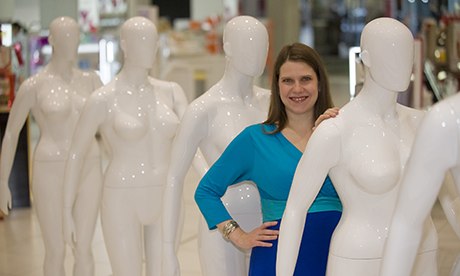
Walking into a fashionable shop and seeing a representation of a body we can recognise as our own is a luxury enjoyed solely by the likes of Gisele Bündchen. So it should come as a salve to our collective souls that Debenhams has announced the rolling out of size 16 mannequins. But actually, it rings as hollow as a supermodel's stomach.
Not because of the statistics: the average British woman is, we are told, 5ft 3in (161.6cm), 11 stone (70.2kg) and a size 16, and there is very little representation of her in consumer culture. But to what extent do these statuettes of promised liberation actually echo that median corpus? Not at all.
Yes, they're bigger than the shiny acrylic skeletons that most shops display in their windows. And they're more human than the trapeze wires used by so many high-end stores to display garments as if no corrupting flesh should ever reside therein. Yes, they have hips and breasts that bear some resemblance to the sort that could once have given birth to and nurtured children. But they're still weirdly super-human. For all their supposedly democratic proportion, they're still flat of stomach and toned of thigh. They're still a body that eludes even the most assiduous gym-goer. No Michelin man rolls here, thanks very much. No arm flab that shakes for five minutes after you move. They are, to all intents and purposes, as impossible a shape to achieve as their waif-ish acetate companions.
To say this is not to decry diversity – or even, let's say it, realism – in the way clothes are marketed and displayed. But to accept it as a sign of changing direction is misguided. It isn't even a bump in the road. We all know the recipe for the fashion industry's body fascism: it's two parts impossibly thin to one part unattainable youth. And these mannequins fall in with all that. There's celebrating the full and natural form of a woman's body, and there's fetishing "curvy" in an un-flabby, cellulite-less vacuum. The physique presented by these mannequins is every bit as unrealistic as the stick-thin limbs of a teenage model. And what they represent is even more harmful, in fact, because they're pushed on us as something "real".
Show me a size 16 woman with a flat stomach (show me any normal woman with one, in fact) and I'll show you the folds of flesh that pile up when I sit down. As shoppers and cabinet ministers both applaud Debenhams' decision to use these bigger mannequins, I'm afraid to say my heart sinks. And my heart is covered with the fatty residue of a woman who likes her food.
To reduce the complex psychology surrounding body image to the waist span of a mannequin is to utterly miss the point. To imply that women are affected by the size of an abstract humanoid in a window display is to equate seeing with believing, and to suggest that women – silly, gullible women – are taken in by the sort of marketing nonsense that we all of us disregard in other spheres on a daily basis.
Do you really think your flat will ever look like the compartmentalised Ikea flat in the catalogue? Does the serving suggestion on your cereal packet ever actually resemble the bowl you have in the morning? Don't even try to tell me that your Iceland prawn ring has ever looked as appetising as the one that Kerry Katona sets down on the table in the advert. It's the height of cynicism to present a marketing strategy as something with moral and social impact. We haven't actually fallen for this, have we?
The way to redress the balance of fashion imagery is not to fight it with an equally unachievable extreme. And it isn't to revel in being average. Because 5ft 3in and 11 stone is not healthy. Any body mass calculator will tell you that it is overweight, with risk of heart trouble. It shouldn't be controversial to point that out.
So for Jo Swinson to suggest that these mannequins are a healthy step for women is not only incredibly patronising, it's also wrong. As wrong as it would be for her to come out in favour of size zero. And for Debenhams to attempt to cash in on that debate is reprehensible. Women aren't fooled by this sort of stuff. We have brains, and we're made of sterner stuff than plastic, whatever size it comes in.
• This article was commissioned following a suggestion made by pollystyrene. If there's a topic you'd like to see covered on Comment is free, please visit our You Tell Us page

